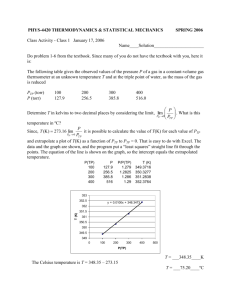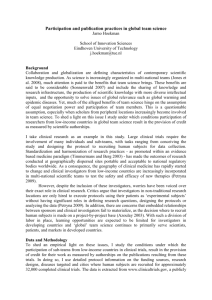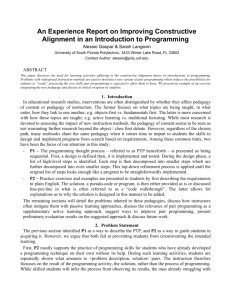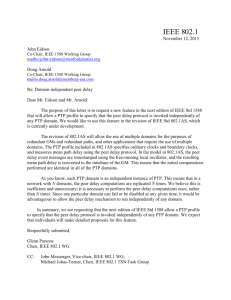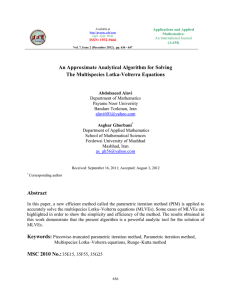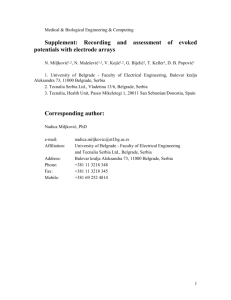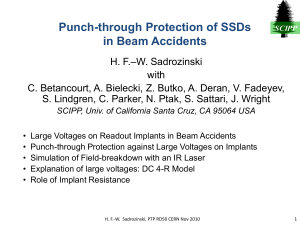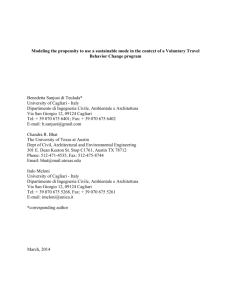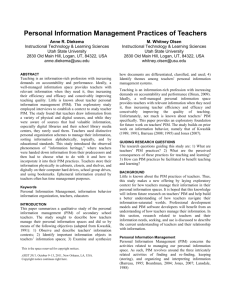An efficient iterative analytical method applied to a nonlinear
advertisement
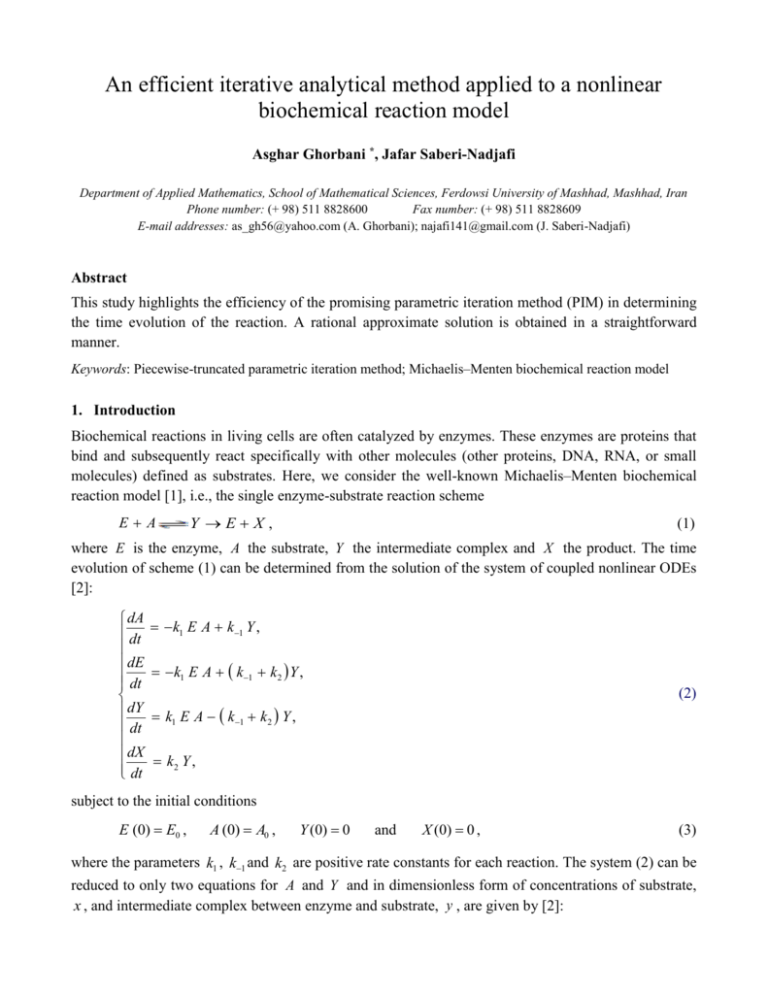
An efficient iterative analytical method applied to a nonlinear biochemical reaction model Asghar Ghorbani *, Jafar Saberi-Nadjafi Department of Applied Mathematics, School of Mathematical Sciences, Ferdowsi University of Mashhad, Mashhad, Iran Phone number: (+ 98) 511 8828600 Fax number: (+ 98) 511 8828609 E-mail addresses: as_gh56@yahoo.com (A. Ghorbani); najafi141@gmail.com (J. Saberi-Nadjafi) Abstract This study highlights the efficiency of the promising parametric iteration method (PIM) in determining the time evolution of the reaction. A rational approximate solution is obtained in a straightforward manner. Keywords: Piecewise-truncated parametric iteration method; Michaelis–Menten biochemical reaction model 1. Introduction Biochemical reactions in living cells are often catalyzed by enzymes. These enzymes are proteins that bind and subsequently react specifically with other molecules (other proteins, DNA, RNA, or small molecules) defined as substrates. Here, we consider the well-known Michaelis–Menten biochemical reaction model [1], i.e., the single enzyme-substrate reaction scheme EA Y EX, (1) where E is the enzyme, A the substrate, Y the intermediate complex and X the product. The time evolution of scheme (1) can be determined from the solution of the system of coupled nonlinear ODEs [2]: dA dt dE dt dY dt dX dt k1 E A k1 Y , k1 E A k1 k2 Y , (2) k1 E A k1 k2 Y , k2 Y , subject to the initial conditions E (0) E0 , A (0) A0 , Y (0) 0 and X (0) 0 , (3) where the parameters k1 , k1 and k2 are positive rate constants for each reaction. The system (2) can be reduced to only two equations for A and Y and in dimensionless form of concentrations of substrate, x , and intermediate complex between enzyme and substrate, y , are given by [2]: dx dt x ( ) y xy, dy 1 ( x y x y ), dt (4) subject to the initial conditions x(0) 1 and y (0) 0 , (5) where , and are dimensionless parameters. The goal of this work is to simulate accurately the system of coupled nonlinear ODEs (4) using a new algorithm called the piecewise-truncated parametric iteration method, where details can be found in [3,4]. 2. The basic idea of PIM In this section, the main ideas of the PIM and the piecewise-truncated PIM algorithms are proposed for solving the nonlinear system (4). The basic character of PIM is to construct a family of iterative processes for the coupled system of (4) as follows [3,4]: t d 1 xn 1 (t ) xn (t ) h Λ (t , s ) H1 ( s) ds xn ( s) xn ( s) ( β α) yn ( s) xn ( s) yn ( s) ds , t0 t d 1 y ( t ) y ( t ) h Λ2(t , s ) H 2 ( s) yn ( s) xn ( s) β yn ( s) x n ( s) yn ( s) ds, n n 1 ε ds t0 where x0 (t ) x(t0 0) c ( 1) and y0 (t ) y(t0 0) d ( 0) are the initial (6) guesses, Λ1(t , s ) , Λ2(t , s ) 0 the general multipliers, and the h 0 denotes the so-called auxiliary parameter and H1 (t ), H 2 (t ) 0 denote the so-called auxiliary functions. The convergence of the iterative relation of (6) was discussed in [4]. It should be emphasized that having the freedom to choose the auxiliary parameter h , the auxiliary functions H1 (t ), H 2 (t ) , the initial approximations x0 (t ) and y0 (t ) is fundamental to the validity and flexibility of the FIM, as will be shown later in this paper by illustrative example. We can assume that all of them are properly chosen so that solution of (6) exists. Accordingly, the successive approximations xn (t ), yn (t ) , n 0 of the solutions x (t ), y (t ) will be readily obtained by selecting the zeroth components. Consequently, the exact solution may be obtained by using x (t ) lim xn (t ) and y (t ) lim yn (t ). n n In general, the application of the above PIM to nonlinear problems leads to the calculation of unneeded terms. Also, it gives a good approximation to the exact solution in a small region of t .To completely cancel these terms in each step and ensure validity of approximations for large t , we apply the version of piecewise truncated of PIM, which is as follows (i.e., we determine the solutions in the subintervals of t , i.e., [ti , ti 1 ) where Δt ti 1 ti , i 0 , 1, 2 ,..., N 1 ): t x ( t ) x ( t ) h Fi11, j (t , s ) ds xi 1, n1 (t ; ti , ci1 , h) , i 1, j 1 i 1, j i 1 tj t y (t ) yi 1, j (t ) h Fi 21, j (t , s ) ds yi 1, n2 (t ; ti , ci2 , h) , i 1, j 1 i 1 tj x (t ) = x (t ) = c1 , j = 0,1,..., n1 1, i i 1 i , n1i i i 1,0 2 2 yi 1,0 (t ) = yi , ni2 (ti ) = ci , j = 0,1,..., ni 1 1, 1 d Λ ( t , s ) H 1 ( s ) xn ( s ) xn ( s ) ( β α ) y n ( s ) xn ( s ) y n ( s ) ds = Fi11, j (t , s ) O (( s ti ) j 1 ) O ((t ti ) j 1 ), 1 2 d Λ (t , s ) H 2 ( s ) ds yn ( s ) ε xn ( s ) β yn ( s ) x n ( s ) yn ( s ) = Fi 21, j (t , s ) O (( s ti ) j 1 ) O ((t ti ) j 1 ), (7) where x0, n1 (t0 ) = x(t0 ) = c01 and y0, n2 (t0 ) = x(t0 ) = c02 . Now, we can obtain the ni1, 21 -order PTP 0 0 approximation xi 1,n1 (t ) and yi 1, n2 (t ) on [t i , t i 1 ] . Thus, in the light of (37) for i = 0,1, , N 1 , i 1 i 1 the approximate analytical solution of Eq. (4) on the entire interval [t 0 , T ] can easily be obtained. It should be emphasized that the stability of PTP were proved in [5]. Also, one can see the above PTP technique provides analytical solutions in [t i , t i 1 ] , which are continuous at the end points of each interval. 3. Numerical implementations To give a clear overview of the content of this study, in this section, the system (4) will be tested by PTP, which will ultimately show the simplicity, efficiency and accuracy of this technique. All the results are calculated by using the symbolic calculus software Maple 11. For the sake of comparative purposes with those obtained in [3], we choose the parameters as α 0.375 , β 1 and ε 0.1. In order to solve Eqs. (4) by using the PTP algorithm (7), for simplicity, we choose Λ1(t , s ) Λ2(t , s ) = 1 and H1 (t ) H 2 (t ) = 1 . Now, according to (7), by taking N = 1000, 5000 and T = 50 , we can obtain the approximations of (4) on [0,50] . Fig. 1 show the approximate solution obtained for Eqs. (4) by using the 4th-order PTP algorithm for h = 1 and Δt 0.05 versus the numerical RK78 solution for a sample interval of t i.e. 0 t 50 . Moreover, the difference between the 4-term PTP solution when h = 1 , Δt 0.05 and Δt 0.01 and the numerical RK78 solution has been given in Fig. 2. Fig. 1 The solutions of x (t ) and y (t ) using the 4-term PTP algorithm ( Δt 0.05 ) and the numerical RK78 algorithm where Solid line: x4 (t ) , Dash line: y 4 (t ) , Circle symbols: xrk 78 (t ) and box symbols: yrk 78 (t ) . Fig. 2 The absolute errors of the solutions of x (t ) and y (t ) using the 4-term PTP algorithm (Left: Δt 0.01 and Right: Δt 0.05 ) where Dash line: E4x (t ) x4 (t ) xrk 78 and Dot line E4y (t ) y 4 (t ) y rk 78 . In closing our analysis, we mention that the well-known Michaelis–Menten nonlinear reaction system was tested by using the PTP algorithm proposed in this paper, and the obtained results have shown excellent performance. References [1] S. Schnell, C. Mendoza, Closed form solution for time-dependent enzyme kinetics. J. Theor. Biol. 187 (1997) 207-212. [2] AK. Sen, An application of the Adomian decomposition method to the transient behavior of a model biochemical reaction, J. Math. Anal. Appl. 131 (1988) 232-245. [3] A. Ghorbani, Toward a new analytical method for solving nonlinear fractional differential equations, Comput. Methods Appl. Mech. Engrg. 197 (2008) 4173-4179. [4] J. Saberi-Nadjafi and A. Ghorbani, Piecewise-truncated parametric iteration method: a promising analytical method for solving Abel differential equations, Zeitschrift für Naturforschung A – Physical Sciences, accepted for publication.
